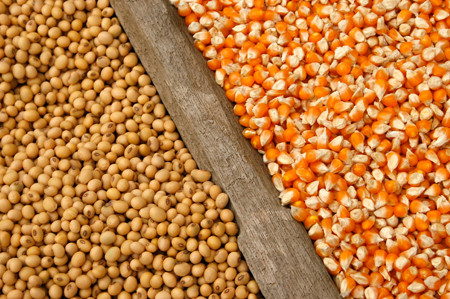Beans, Corn Higher in Overnight Trading; Deere Says Industry Sales to Rise Globally, Not in the US
 (Agriculture.com) – SOYBEANS, CORN HIGHER AS ARGENTINA HARVEST MAY BE DELAYED
(Agriculture.com) – SOYBEANS, CORN HIGHER AS ARGENTINA HARVEST MAY BE DELAYED
Soybeans rose in overnight trading amid concerns that some parts of Argentina are too wet to harvest and amid strong demand for U.S. products.
The rain in Argentina has been mostly beneficial to crops in the country, but it may prevent some growers to begin harvest, according to weather forecasters.
Soybean and corn prices also were higher amid signs of strong demand for U.S. supplies. The Department of Agriculture said last week that sales of corn since the start of the marketing year on September 1 are up 63% from the same time frame a year earlier to 42 million metric tons; soybean sales are up 24% to 51.7 million tons.
Wheat sales since the start of the marketing year on June 1 have totaled 24.2 million tons, up 39% year over year, according to the USDA.
Soybean futures for March delivery rose 5¼¢ to $10.37¾ a bushel overnight on the Chicago Board of Trade. Soy meal futures rose $1.90 to $341.50 a short ton, and soy oil lost 0.13¢ to 32.76¢ a pound.
Corn futures added a penny to $3.69¼ a bushel in Chicago.
Wheat futures for March delivery fell 2¢ to $4.39 a bushel. Kansas City wheat declined 2¼¢ to $4.67 a bushel.
DEERE SAYS INDUSTRY SALES TO JUMP THIS YEAR – JUST NOT IN THE U.S.
John Deere last week reported earnings that were better than analysts had forecast and said sales likely would rise in 2017 for the first year in three.
Chief Executive Samuel R. Allen said in a statement on Friday that the company continued to face “soft market conditions” in its fiscal first quarter of 2017, but that it is “seeing signs that after several years of steep declines, key agricultural markets may be stabilizing.”
The problem, however, is the markets to which he’s referring are in South America.
Deere’s worldwide sales of agriculture equipment are expected to increase by 3% this year. Industry sales in the U.S. and Canada, however, are still expected to be down 5% to 10%, the company said. Sales in the European Union for the industry, as a whole, also are forecast to be down about 5%.
“The decline, reflecting weakness in the livestock sector as well as the continuing impact of low crop prices, is expected to affect both large and small equipment,” Deere said.
South American industry sales, on the other hand, are projected to rise 15% to 20% in fiscal 2017 as a result of “improving economic and political conditions in Brazil and Argentina,” Deere said. Asian sales are forecast to be flat or up slightly on higher sales in India.
The company has been cutting costs amid the soft agricultural market in the U.S. During the fourth quarter last year, Deere announced “voluntary” employee separations that will in 2017 save about $70 million. That, the company said, will allow it to perform “far better” than in past downturns. Overall, Deere wants to slash structural costs by $500 million by the end of 2018.
FIRES MAY SPREAD QUICKLY IN DRY NEBRASKA, SOUTH DAKOTA
Warm, dry weather has left much of east-central Nebraska in a red-flag warning in which wildfires can spread quickly.
The area last week saw snow and cold temperatures. Things have taken a turn, however, to warmer- and drier-than-normal conditions, making for tinderbox conditions. Winds are expected to gust up to 30 mph and humidity is forecast to be extremely low, the National Weather Service said.
Any planned burning should be postponed, as fires likely will spread very quickly. Moisture content in much of the grasslands in the area is extremely low, meaning fires will start easily and spread quickly, the NWS said. Temperatures are expected to be in the mid-60s to mid-70s in the region.
Most of western South Dakota also is at risk of “extreme fire danger,” the NWS said.




